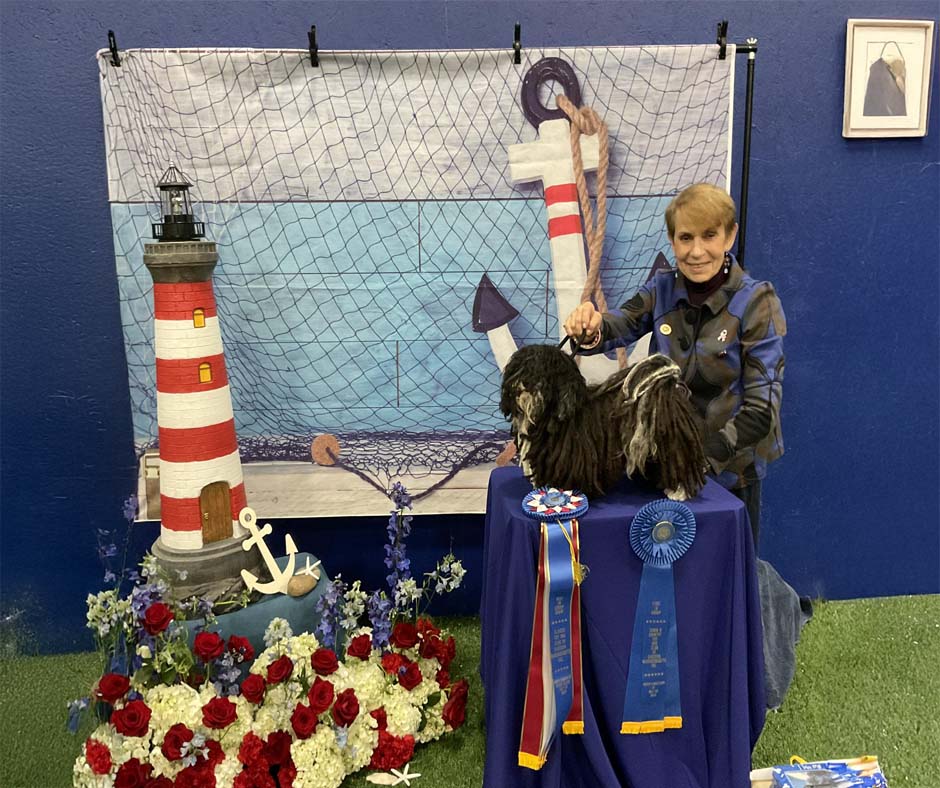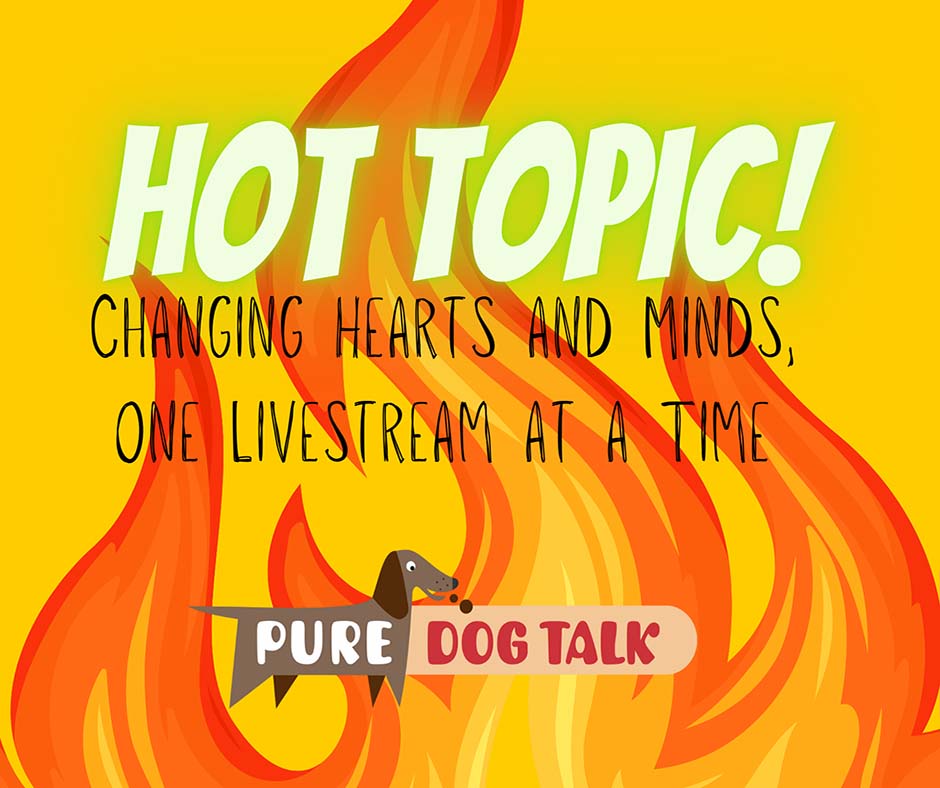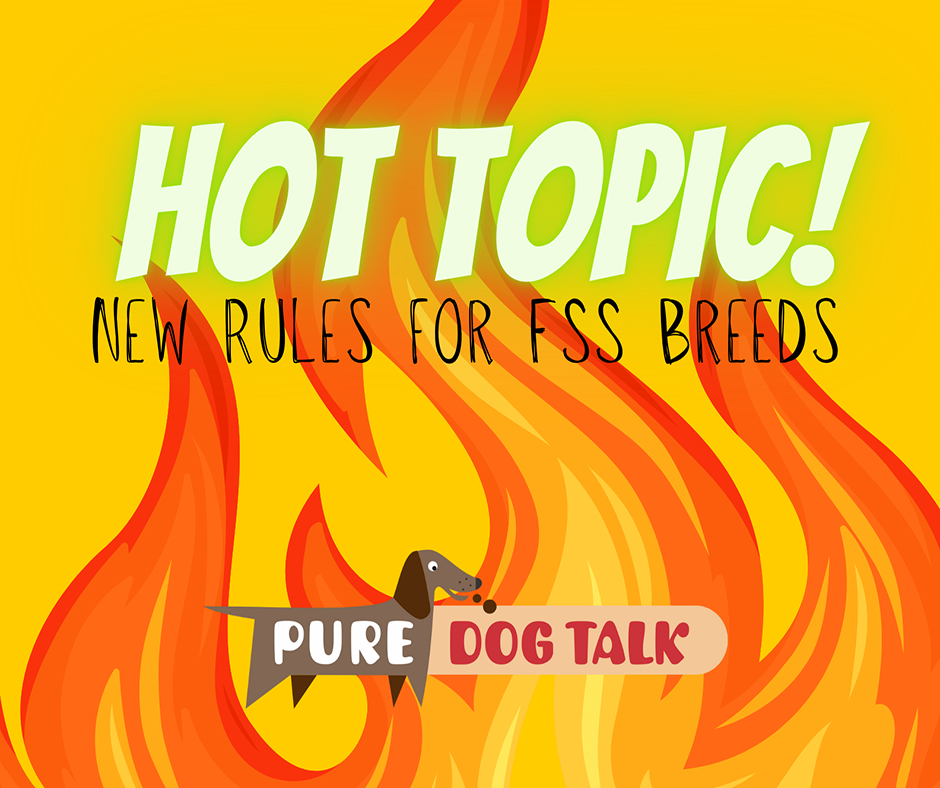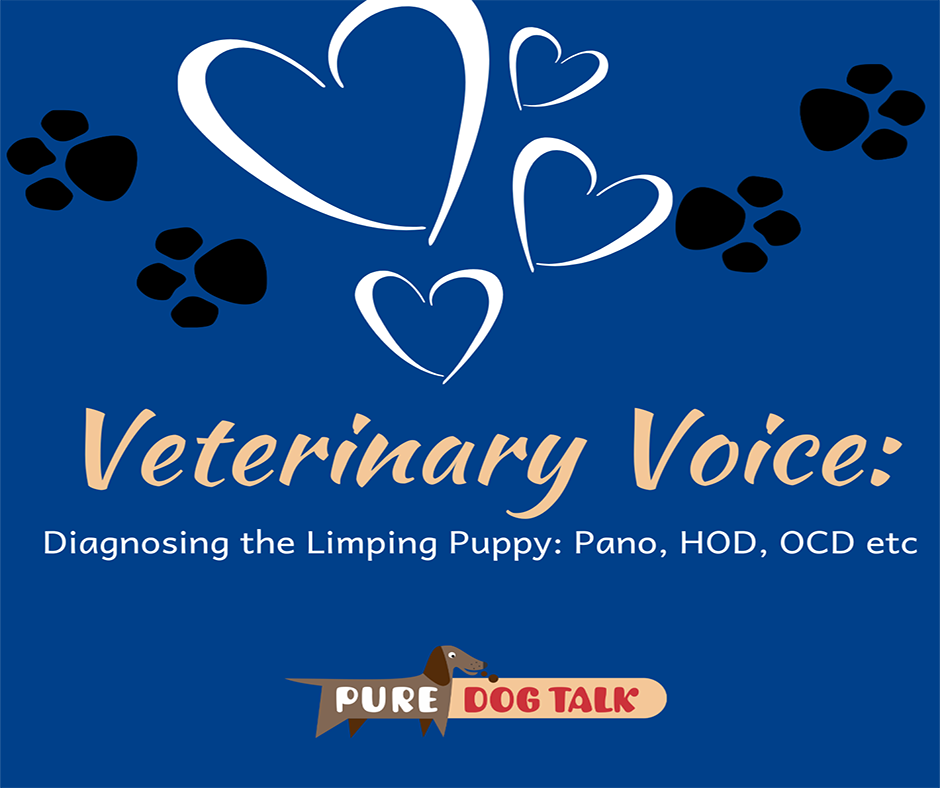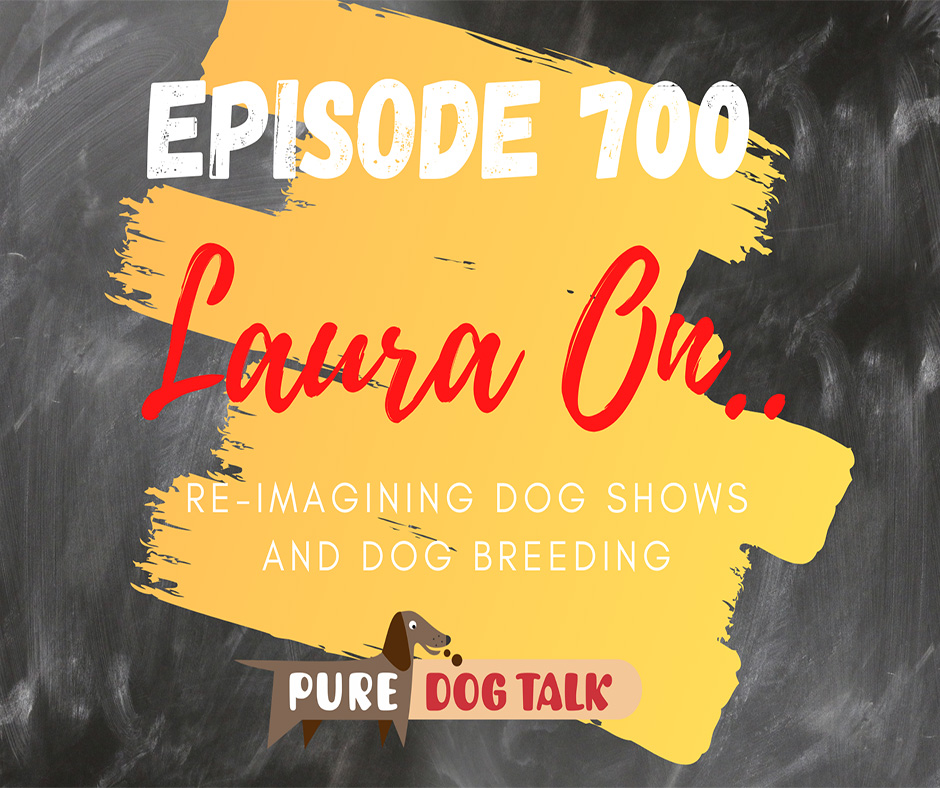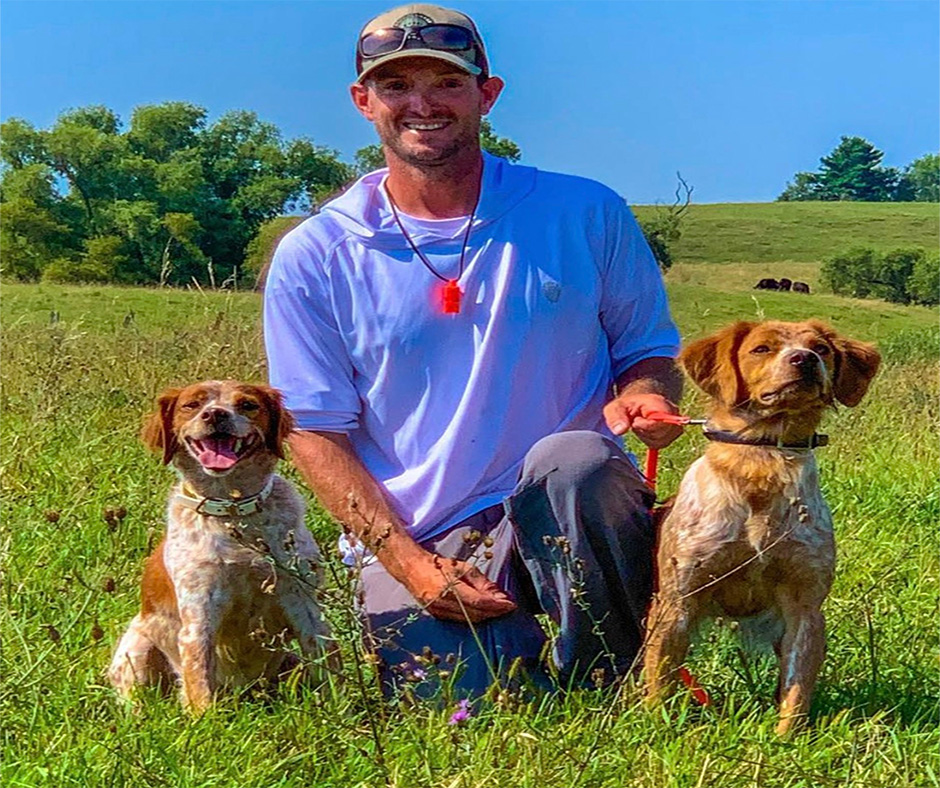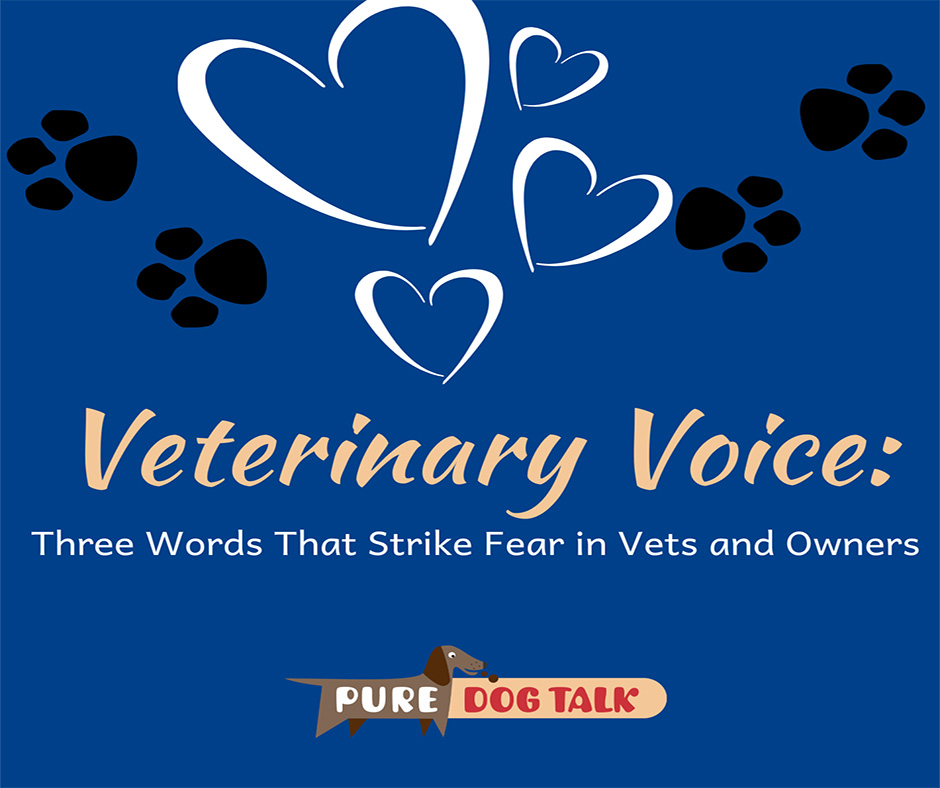Posts by Laura Reeves
707 — Breast Cancer Awareness for You AND Your Dog
Breast Cancer Awareness for You AND Your Dog
Host Laura Reeves is joined by Dr. Marty Greer for an important reminder about the risks of breast cancer in our dogs and how to prevent and treat it.
October is Breast cancer awareness month:
How does hearing the words “she’s got breast cancer” affect you? Bring tears to your eyes? Start a knot forming in the pit of your stomach? Make you want a second opinion? Create anger at being cheated?
The diagnosis:
We all know and have been affected by someone with this dreaded diagnosis. Maybe it is you, maybe someone you love: a wife, sister, daughter, girlfriend, mother, another family member or co-worker. We know it is a life-changing experience – pain, surgery, chemotherapy, radiation, fear of a shortened life expectancy.
For many women, they are fortunate that advances in early detection and medical therapy has made breast cancer a story of survival instead of a death sentence. But this is not the path for all those diagnosed.
Some are diagnosed too late or with a very aggressive form of the disease. Some cannot afford the medical care that allow for an improved prognosis. Some deny themselves the care they need.
But for those who are blessed with great diagnostics and treatment that allow for stories of happy endings, they owe their successes to the incredible research that led to this improved prognosis and outcome.
Part of the success story is thanks to the similarity of breast cancer in women with mammary tumors our dogs also are affected by. The dog has served as a research model for the disease in humans. Many advancements in human medicine are directly linked to the information discovered by research on the disease in dogs. Sadly, our dogs have not benefitted as much as humans have.
In human medicine, there are two keys to survival: early detection and successful treatment. Self-breast examinations and mammograms have been credited with changing survival by early detection. Many organizations have put their resources into educating us about the importance of these two important detection tools. New diagnostic tools are on the horizon for humans. Of course, mammograms are not available for our dogs. They rely on us to detect their lumps and to seek appropriate therapy for treatment.
Treatment:
But, treatment is a very different story. Despite the similarities between this human and canine disorder, there are no widely accepted successful chemotherapy and radiation therapy programs available for dogs. Surgical excision is the only treatment option widely available at this time for dogs.
Prevention:
In contrast to humans, mammary tumors in dogs are nearly 100% preventable if owners would take one simple step – to spay their female dogs prior to age 2 or younger. We all know that spaying (ovariohysterectomy or ovariectomy) prevents heat cycles and pregnancy. What we have not always done as well as we should have as veterinarians is to educate our clients that spaying under the age of 2 prevents most mammary tumors. Spaying before the first heat cycle protects nearly all dogs.
In the veterinary profession, we have also not educated our clients of the risks of spaying our female dogs. While it is true that spaying prevents pregnancy, mammary tumors, and pyometras, there is research that supports increased risk of other disorders thought to be related to removing the hormonal influence of the ovaries. There is an increased risk of urinary incontinence and associated urinary tract infections, osteosarcoma, lymphosarcoma, hemangiosarcoma, mast cell tumors, and hypothyroidism. Each of these disorders has an associated health risk ranging from mild to severe affecting quality and length of life, as well as financial cost to the owner. Even when dogs with mammary tumors were included in the study, they still achieved greater longevity than their spayed female counterparts.
More information on the scientific literature that supports this can be found at:
-
http://onlinelibrary.wiley.com/doi/10.1111/j.1474-9726.2009.00513.x/full
-
www.naiaonline.org/pdfs/longtermhealtheffectsofspayneuterindogs.pdf
-
https://www.ucdavis.edu/news/neutering-health-effects-more-severe-golden-retrievers-labradors
-
https://www.ucdavis.edu/news/early-neutering-poses-health-risks-german-shepherd-dogs-study-finds
-
http://www.akcchf.org/educational-resources/library/articles/an-update-on-the-health.html
Individualized veterinary care:
These studies show that the decision to spay and when to spay an individual dog cannot be made without balancing the risks and benefits of the procedure.
As a group, veterinarians and animal control organizations have encouraged spaying, sometimes at a very early age, with the only goal being population control. We have overlooked the importance of individual dog health, meaning the health benefits of leaving our female dogs intact (i.e. not spayed). Instead, we have allowed public policy for the greater good of dog population control to dictate our decisions that we should spay and when we should spay our individual dogs.
Each individually owned dog should be considered an individual – there is not a one-size-fits-all way to approach this decision. More research needs to be done to aid in determining the optimal time for a spay.
For the dogs who are not spayed at this early age due to their inclusion in a breeding program or for other health benefits, early detection is still key in creating a favorable outcome for the patient and her family. Early detection in the dog is simple – it only requires a monthly examination by the owner and biannual examinations on palpation by her veterinarian. For dogs groomed frequently, professional groomers may be enlisted in this hands-on approach as well. This simple “Pink Paw” program will allow for early detection for nearly all mammary tumors. When detected early, surgical removal will usually lead to a cure.
Of course, for our dogs as for us, a healthy lifestyle with an appropriate diet, exercise, good weight management, preventive veterinary care, and the fortune of good genetics will allow for maximum longevity.
Should we call this “breast cancer?”
The same disorder we see in women and call “breast cancer” is called “mammary tumor” in the dog. This terminology does not motivate owners to respond to this as a serious health threat to their dog. Although an accurate description, mammary tumor is too bland a term to use when a call to action is the best response.
We need to think of this malady in dogs as we do in women – a disorder that requires prompt surgical treatment. Since surgery is our only real option for treatment of “breast cancer” in the dog at this time, owners and veterinarians alike should opt for wide surgical excision of any suspect masses as soon as possible to improve long-term survival of the affected patient. (The only exception to this is in the rare case when inflammatory mammary carcinoma is suspected; in this case, surgical excision is not an appropriate treatment.) Pre-op needle samples of suspected mammary tumors does not lead to accurate prediction of the severity of the possible tumor.
Taking a “let’s watch it and see what it does” approach to a lump is likely to allow a treatable disorder to rage out of control and become a life-threatening disorder. Each heat cycle she has will likely lead to an increase in the size of the breast tumor. Spaying at this time is likely to help prevent the continued risks of mammary cancer in dogs who are predisposed to recurrence.
There is a known strong correlation between the size of the dog and the size of the tumor and the malignancy rate – overall, 50% of breast cancer in the dog is malignant. Small dogs and small tumors are less likely to be serious than large dogs and large tumors. Early surgical intervention has the best outcomes at this time.
As in women, early detection and treatment leads to a much better prognosis and long-term survival rate.
The now?
This October, if you visit any of our 4 practice locations, we are working hard to educate our dog and cat owners about breast cancer. Our team will educate you on how to do an effective breast exam on your dog or cat. Please remember to do this monthly, just like you do your own breast exam. Should you find a lump anytime between October and next April, you may return and have a technician assess the lump at no charge. If there is any suspicion of mammary cancer, one of our doctors will also do an assessment and help schedule your pet for surgery if there is reason for concern.
The future?
As we know more about the prevention, early diagnosis, and treatment of breast cancer, we as well as our dogs can look forward to a long and healthy life free of this devastating disorder.
Dr. Marty Greer and Veterinary Village in Lomira has initiated a research fund with the University of Wisconsin Veterinary School. This fund has been created: Excellence in Companion Animal Mammary Cancer Research Fund and is ready for your donations.
The direct link to the fund via UW’s giving page for online gifts: https://supportuw.org/go/xGMyf
The expectation is to fund research to If you prefer sending a check for your personal contribution, you can issue it payable to:
UW Foundation
Fund 112840163 (write on the check memo line)
Mail to:
UW Foundation
c/o U.S. Bank Lockbox
Box 78807
Milwaukee, WI 53278-8807
Feel free to share this link with anyone who might be interested in supporting this work.
Additionally, there is a beautiful silver necklace featuring the Pink Paw logo with matching tags for dogs you can purchase in support of the foundation.
Please contact us at Veterinary Village for additional information:
Email: vv@k9stork.com; Phone: 920-269-4000
Mail: Veterinary Village, N11591 Columbia Dr., Lomira, WI 53048
706 – Queen of Cords: Alice Lawrence on 55 Years of Corded Breeds
Queen of Cords: Alice Lawrence on 55 Years of Corded Breeds

Alice Lawrence with BISS GRCHB Fuzzy Farm All Things Considered (aka Spaetzle, on the left) and YOLO (on the right) Moonshadow You Only Live Once At The Fuzzy Farm.
Host Laura Reeves is joined by Alice Lawrence, breeder-owner-handler of Komondorok, Puli and Havanese, to discuss her beloved corded breeds.
Lawrence, along with her husband Steve, first owned an Old English Sheepdog. “We were brushing our arms off,” she said.
“In 1972, we acquired our first Komondor and there’s no looking back. And no, we never had another Old English Sheepdog. We love the breed. But we would never go back to brushing a dog like an Old English Sheepdog when you can have a dog of equivalent size or somewhat larger and be able to cord it.
While cording a coat can seem daunting, Lawrence said, “Well, compared to brushing, it is (much easier), but you have to understand what a cord is, why a coat cords, and how to maintain the cord. It’s a different discipline. We think it’s much easier than brushing, and it’s a lifetime of being able to have your dog in a proper coat rather than brushing the dog, showing it and shaving it down because you can’t keep up with brushing it.”
A “curated mat”
“We think of cords as being a protection, a protection from predators. And the coat is very important to the environment and to the work that they do. Komondor are protectors of the flock. They do guard against such things as wolves. A fully-corded Komondor, not necessarily the length of the coat, but the density of the coat, will prevent the wolf from biting the dog.
“The other thing is that Komondor and Puli in their native Hungary deal with very, very difficult weather conditions, and the coat protects them both from the cold as well as from the heat. It’s an insulator. So it’s really a very natural coat for the dogs to have for their entire life.
“To cord any breed you really need a coat that is a double texture, an undercoat and an outer coat, and the undercoat is a softer coat, it’s more cottony. The outer coat is wavier and it takes the wave of the outer coat to wind its way around the softer undercoat to create the cord.
“That’s what’s creating this, call it a mat. It’s a mat and it’s an elongated mat. The thickness of the mat, sometimes it’s natural as to whether or not a dog has a thick cord or a thinner cord, but for the most part it’s how you divide these mats that occur that will determine the thickness of the cord.”
705 – Changing Hearts and Minds, One Livestream at a Time
Changing Hearts and Minds, One Livestream at a Time
Host Laura Reeves is joined by friend of the pod Bobby Brian (BB) Lewis to talk about how he was able to change the minds of random members of the public using his YouTube channel.
Lewis started his YouTube channel primarily to share with his puppy families and show how the puppies are raised. He said he was shocked by the amount of negative feedback and outright hate toward dog breeders that he received.
“The easiest thing would have been to remove them from the channel. I mean, I don’t know if that would be the best thing to do, but that would have been an easy fix to this. But I was trying to explain to them this is what we do. We do all the health testing on our parents. They must be at least two years old and have all their health certs before we breed them. And normally we like to even have a title on all of them before we do this.
“One of the comments I had gotten was you’re adding to all these puppies being put into shelters. And I said, “No, if you buy a puppy for me and you have to surrender it or if you change ownership, I have a contract and that puppy comes to me.
“There’s no way one of my pups will wind up in a shelter, and (the commenter) just, he didn’t know what to say that night. That guy was stunned.
“My eyes opened up all of a sudden and I was shocked that people were trying to call me out. To some degree you’re thinking you’re doing, which I know I’m doing the right thing, but when people start calling you names and those type of things, and then you’re like, whoa, wait a minute, something’s wrong, we need to stand up a little bit.”
704 – The New and Aspiring Judge’s Journey with Channing Sheets
The New and Aspiring Judge’s Journey with Channing Sheets
“How you treat people is everything.”
Host Laura Reeves is joined by German Shepherd Dog breeder and recently minted AKC judge Channing Sheets for a conversation about breeding dogs, the sport, judging and the honor of his first Westminster Kennel Club judging assignment.
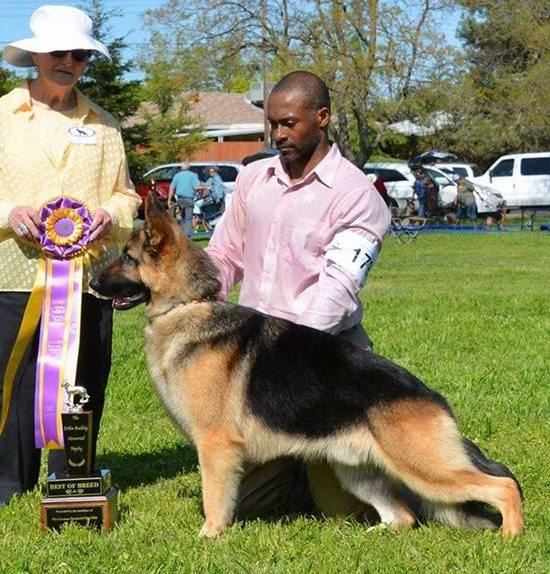
Channing Sheets with one of his GSD.
Sheets recounts his journey in dogs, starting with his dad’s bird dogs and hounds, through Keeshond and finally landing with his passion, the GSD.
A member of the GSDCA Judges Education Committee, Sheets said the breed “has to be able to tend stock. You gotta do it all day long. You have to have good heart and lung function and then the secondary job is bite work. So you need to have a good bite, you need to have all your teeth and you need to have good occlusion. Now a button first premolar is a fault just because it’s not a gripping tooth. Anything else I’m pretty much death on for that reason.”
Like so many fanciers who are much more than just their dogs, Sheets works in high level occupational safety for the state of California. “I got recruited away to go to Cal OSHA and I was writing ebola guidelines and pandemic influenza guidelines. I do a lot of outbreak investigations, but I also specialize in workplace violence. So I deal with high profile active shooter cases.”
“How you treat new people makes or breaks whether you get assignments, whether they want to show to you, or whether those individuals will continue to participate.
“I really focus on puppy because I don’t want them to have a bad experience,” Sheets said “and I don’t want a new person to have a bad experience. Those are the two that we want to keep coming back. And if you do that, and they bring their friend, you’ll grow exponentially, but you have to make positive experiences. Yeah. No one wants to go somewhere where they’re going to have a negative experience.”
703 – Hot Topic: New Rules for FSS Breeds
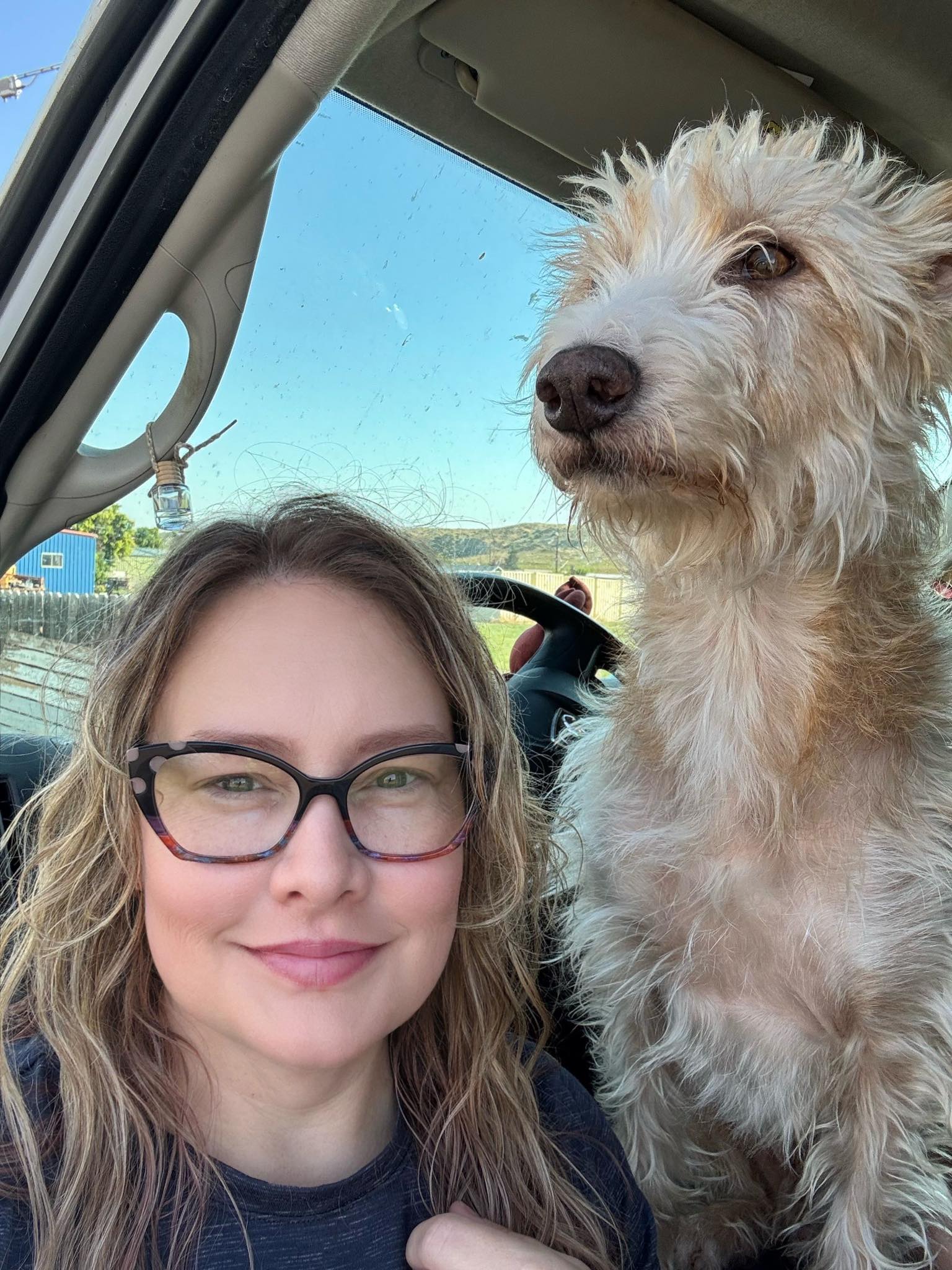
Veronica Miller and a Portugese Podengo Medio.
Hot Topic: New Rules for FSS Breeds
Host Laura Reeves is joined by Veronica Miller, Portugese Podengo Medio enthusiast, to discuss newly announced rules about FSS breeds.
The August Board minutes launched a number of hot topics and discussions, including around limited registrations, but one of the hottest is taking place in the FSS community. The enthusiasts in this group are working with breeds progressing toward full AKC recognition. Many of these breeds are ancient and popular in other countries.
“Since I came in initially,” Miller said, “we had to have 300 dogs registered. We met that. Then it was you had to have a minimum of 20 litters. We had hit that, but then they moved it to 20 liters within five years after moving to miscellaneous. We’re about one litter away from meeting that and now it’s 20 litters within three years.
“And most of these changes have taken place since 2018. So, in a short number of years there have been a whole lot of changes. There has been no outreach to any of our breed clubs. We hear from AKC that they are a club of clubs, but changes are made for FSS and miscellaneous breeds without our input. And without any discussion or reasoning.
“We want to make sure that we do have a healthy gene pool and good genetics within our breed. We also want to make sure that we have appropriate homes and forcing a set number of litters could potentially lead to people making poor decisions for the dogs.
“And the other thing with this particular board decision that really, I think, pushed a lot of buttons is when things come before the board, it is brought before the board discussed and then they leave it until the next board meeting when it’s been voted on, which allows for a feedback. And that did not happen.
“A lot of this group is the under 40 crowd, which is not the usual. We have found breeds that we love and want to dedicate our lives to, and just because it’s not the usual breed that’s out there, it doesn’t make them worth any less. We have the breeds that we have because they are special to us. And these folks are incredibly dedicated to these dogs.
“We are really dedicated and want to do more with our dogs, which is the whole point here, but we’re being held back in so many ways. And unfortunately, that’s going to turn these folks away from AKC and they may go to other venues or they may just stay at home with their dogs. And then we’re losing a huge segment of people that could really grow our sport.”
702 – Diagnosing the Limping Puppy: Pano, HOD, OCD and more…
Diagnosing the Limping Puppy: Pano, HOD, OCD and more…
Host Laura Reeves is joined by Dr. Marty Greer for a deep dive on all the causes of a limping puppy. They cover when to have the puppy seen by a vet and what differentials are in play for the diagnosis.
Panosteitis. Hypertrophic osteodystrophy. Osteochondritis Dissecans. These are long, scary names of disorders that can adversely impact our puppies while they are growing. From the relatively benign Pano to the frequently surgical solution for OCD, every time we see a limping puppy, our stomachs clench.
Greer walks listeners through all of the various options and discusses the heritability of these disorders.
“Make sure that you stay in good communication with both your veterinarian and the breeder,” Greer said, “because as an alliance, we can really make a big difference in how these puppies are diagnosed and treated.
“Pano, I think growing pains is a pretty accurate description, and it’s typically a young puppy usually at their most rapid growth phase, somewhere between 5 and 8 or 9 months of age. And they’re usually but not always males. I know I’ve had it in females. The very worst case I. First Soft Piano was a female and it was not a heavily boned dog, but typically we think of them as heavy boned, like large bone dogs that have a lot of structure and typically boys because they typically have those thicker bones and more rapid growth than the things that boys do that girls don’t.
“HOD typically strikes when the puppy is younger. It’s going to show at the growth plates on an x -ray, they’re going to show up as this widening, this weird kind of fuzzy look there. It is very painful, dogs have a fever and it’s often associated with a vaccination.
“OCD is generally noticed at 6-15 months. Cartilage in the joints peels off and difficult to diagnose in xray. Usually the shoulder, but not necessarily.
“Fragmented Coronoid Process (FCP) and Ununited anconeal process (UAP) and Premature ulnar closure are growth disorders in the elbow related to elbow dysplasia.
“Anytime you can say it’s more common in this breed than another breed that means it’s genetic.”
701 – PennHIP for the Win on Reducing Incidence of Hip Dysplasia
PennHIP for the Win on Reducing Incidence of Hip Dysplasia
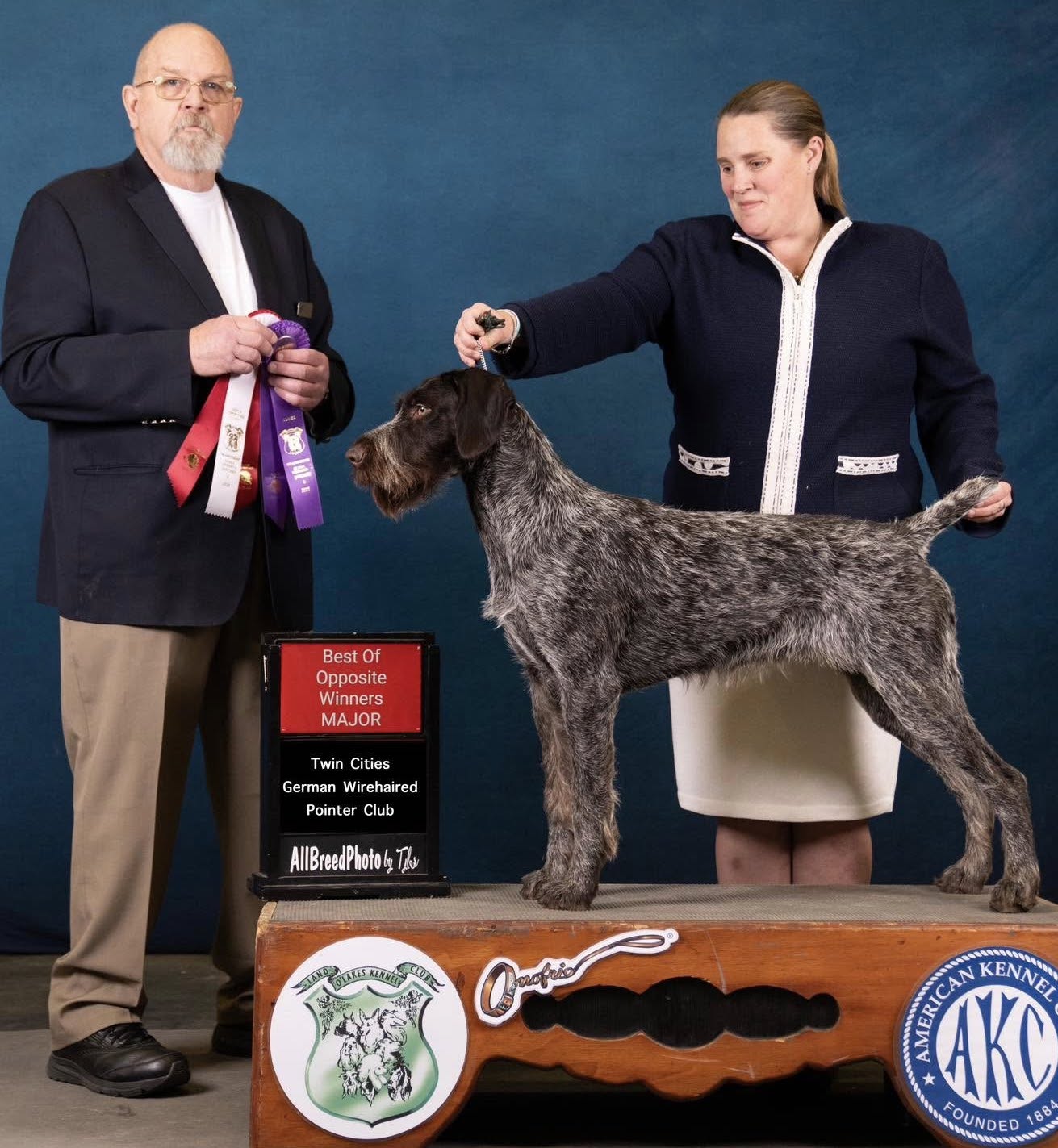
Dr. Karen Potter showing one of her German Wirehaired Pointers.
Host Laura Reeves is joined by Dr. Karen Potter to discuss the value of PennHIP evaluations to reduce the incidence of hip dysplasia in a breeding program.
“While yes, I do PennHIP my dogs,” Potter said, “I typically will go back and still get an OFA score on them. So I have both avenues to look at as I’m going through my breeding. With Penn Hip, we’re able to have a number that I can use in order to then go forward with breeding and that gives me an idea of if I have a dog with a higher laxity score to then breed that to a dog with a lower laxity score to try to continue to bring the number down in the offspring trying to improve the quality.
“What the PennHIP program has done is they determined the laxity score, which is how much the hip joint is able to luxate during movement. We all know the hip is a ball and socket joint and the laxity being how much the ball can come out of the socket. And so when that ball comes out of the socket, in each step, they found that those forces and each concussive force is what we then develop osteoarthritis from.
“When we’re looking at a PennHIP score, we’re looking for a score that is smaller, lower numbers are better. So it’s a distraction value saying this is how much we can passively distract the hip from the socket. And I say passively because we’re doing this while the dogs are under heavy sedation or anesthesia.”
Listen in to take a deep dive into the world of PennHIP scores, how the test works, what it tells breeders and how to use the scores in a breeding program.
For additional information on the studies done on the efficacy of this testing method check out this LINK.
700 — Laura On: Re-imagining Dog Shows and Dog Breeding
Episode 700: Re-imagining Dog Shows and Dog Breeding
It’s become a tradition here at Pure Dog Talk to celebrate the important milestones. Episode 700 feels surreal to me! Since November of 2016, NINE years, I’ve been hopping in the van with you guys for your road trips, joining you on the treadmill and the lawnmower, at the grooming table and discussions around the dinner table. Crazy talk!
But, here we are. This year we even kicked off a new adventure with the Marty and Laura Show, reaching out to the general public, your puppy buyers and your cousin’s uncle’s girlfriend with trusted, knowledgeable information on all things pet health.
We’ve also developed the Pedigrees to Pups Seminar series and are actively in process of making those available as courses on demand.
I’ve got a new audio book about to hit the shelves and a long list of really excellent conversations upcoming. So the future looks bright in podcastlandia.
I’m just a little concerned I’m going to be talking to myself here eventually. As I watch the sport of dog shows dwindle, litter registrations drop off and dog breeders retire, age out, drop out and give up, it gives me pause for our future.
I had a call recently from a long time judge who shared my concerns about the “future of the sport.” It’s not a new conversation. It’s been around for at least the last 25 years. And we’re still here chugging along. A little more spread thin with lots and lots and lots of small shows. A little greyer and gimpier. My friend discussed various initiatives from AKC that she thinks are to blame. But honestly I think it’s simple.
Dog shows are expensive. Breeding dogs is ridiculously expensive. And really hard. You get the tremendous highs but those heartbreaking lows are really hard to take. Those of us who have dedicated our lives to this can’t understand why people don’t want to abuse their bodies, emotions and wallets for the chance at creating that one big winner.
But a thing one of my guests said recently has really stuck with me. In his book Familiaris, David Wroblewski touches on a theme that I think we need to let roll around in our minds for a while.
His fictional dog breeder character describes the importance of creating something lasting and beautiful in the world. The idea of pursuing one impossible thing. That dog breeding is something like a “great quest” and gives our lives purpose.
So here’s my pitch.
We need MORE dog breeders, not fewer. But we need more GOOD dog breeders. People who put the dogs not the profit margin first. Not saying making money is a sin. It isn’t. But when you center the dogs, the breed and the buyers, you might not retire a billionaire, but you won’t go broke either. We’ve spent a good bit of time this year on providing content that helps people understand HOW to do this and do it well. That’s a big part of why we created the Pedigrees to Pups seminars. We had Matt Stelter on to talk about website and content creation. We talked to my friend BB who started a YouTube channel with his Brittany litter.
My challenge, dear listeners, is to extend your involvement. If you haven’t yet, consider working with your breeder to whelp and raise a litter under their guidance. Decide that ribbons get dusty, but building a strong family of dogs who will go on to bring joy to hundreds maybe even thousands of people over multiple decades is a vision worth having. It is a lifetime project that is WORTH your time, your effort, your investment, your blood, sweat and tears.
Because I promise you, when you start walking toward the end of your path, and you look back at your “body of work” with pride and love and the extended family of puppy buyers going back decades, it IS worthy of your effort.
Building something lasting doesn’t have to be a bridge out of concrete. It can be as real and as warm as the trusting gaze of an old friend looking out at you from the eyes of a new puppy.
We don’t have to buy the propaganda that PETA has sold us. We don’t have to hide our dogs and our passion. We don’t have to accept that the general public has zero concept of animal husbandry. WE can be the difference. We can use our voices to educate. If you aren’t comfortable speaking yourself, share resources like this one or the marty and laura show. AKC has resources. Our world is *drowning* in information that isn’t getting to the audience that needs to hear it. Preaching to the choir ain’t going to fix it y’all.
We don’t have to accept anti breeder legislation. WE can introduce ourselves as subject matter experts and be the ones the lawmakers call when in doubt. WE do have the power of our own destinies. Somehow, we have allowed those to be stolen from us by slick slogans and people who have never bred a litter of puppies in their lives telling us how to do what we do. And I don’t mean AKC. I mean YOU. Literally, you. Our numbers may not be legion, but our passion is.
It is long past time that we stand proud with that in our communities.
So, do a quick check on your heart. Are you showing that gorgeous bitch to her triple quintuple grand champion platinum? How about you breed her? Or at least support someone in the trenches who is doing the work and buy a new dog. And yes, you can find someone to sell you a good dog. I promise. If you’re struggling, email me. I’ll help.
We need you guys, All y’all, to hang with it. To dream. To plan. To get knocked down and *get back up again*! No matter what tragedy, what horror, what sadness or betrayal, it’s a safe bet you aren’t alone.
Surround yourself with positive people who find constructive ways to improve instead of finding other people to blame. Find your tribe. If you haven’t already, I invite you to join ours. The Pure Dog Talk Patrons community is deep and rich with support and knowledge and camaraderie. Stop by the website and click the Patrons tab to join us.
Everyone starts somewhere and certainly I’m no exception.
Nine years ago I didn’t know what a podcast even was. Mary kept pushing me to host this thing and I just was baffled. I googled and poked around and most of them were booooooring things about stuff I couldn’t understand.
Then I ran across a name I knew! Back in the Seattle days, I was running the Human Rights Watch Film Festival and one of our sponsors was The Stranger, a sort of alternative newspaper. The primary reason it was semi famous was one columnist, a dude I knew to wave at by the name of Dan Savage and his, mmm, quirky sex advice column called Savage Love. And there it was! The Savage Love podcast!
He had *500* episodes at the time and I figured I’d make it a goal to surpass that…. I’m past that now, but I haven’t quite managed to eclipse the kinky sex pod, so I guess we’ll just have to keep trying! And that’s kind of a circular way of making my point … Keep going, find a way to motivate yourself and keep going some more.
While you’re at it, help me beat Savage Love! Like, share, review and subscribe.
Talk ON. Peace….
699 – Jake Bartells on NAVHDA, Epagneul Breton and Dog Clubs
Jake Bartells on NAVHDA, Epagneul Breton and Dog Clubs
Host Laura Reeves is joined by Jake Bartells, a member of the North American Versatile Hunting Dog Association (NAVHDA) and breeder of Epagneul Breton. Their wide-ranging conversation about the inherent challenges of dog clubs is applicable to any club, of any type, anywhere.
About NAVHDA
“NAVHDA is an organization of about 10,000 members,” Bartells said. “It’s mainly a testing organization that gathers data in a registry and that’s where it houses the data is through the registry. All of the tests are done per a standard. So you’re judged against the standard and each dog tested and each member has both a handler record and then the testing record for the dog. That data in an ideal world is used by breeders to then continue and better the breeds that we recognize and it’s super useful.”
About Dog Clubs
“(It’s important) to have a complete transparent communication with (the membership). I think they deserve to know exactly where the organization’s at at all times and not have to ask for it, have it be provided and put out there. I wanna see financial strength in the organization, having money gives you resources that allows you to do more, and then just absolutely upholding our mission, mission first by all stretch. I think that’s done through building teams of great people. Nobody has to do the job alone. For a living, I project manage and I can’t build a house or build a casino or build anything else without teams and upon teams of great talented people. And with 10,000 members, we have an unbelievable amount of very talented people in very specific fields and most of which are willing to do it for the organization.
About Epagneul Breton vs Brittany
“It’s one of those things where on paper, it doesn’t look that different. When you bring two dogs out, it doesn’t take a trained eye to start picking them out at a separate dogs very quickly and especially in the way they run. You know, the French say that they should run like a pig. They should have a shorter, choppier stride that comes from being, “cobby.” They’re as tall at the withers as they are long. And so they should move in that manner that’s a bit different.
“We can have orange and white, liver and white, liver, tri-color, and then orange tri-color, and black and white. The easy distinction is they’re gonna have black nose, black lips, black eyelids, and they can have black on their heads, black toenails. So even the orange and whites are going to have black nose, black eyelids. It’s never going to look like the pink nose of an American Brittany.”
698 – Three Words That Strike Fear in Vets and Owners
Three Words That Strike Fear in Vets and Owners
Host Laura Reeves is joined by Dr. Marty Greer talking about the three words that strike fear in both veterinarians and owners.
“These three things are what can take a normal, easy, lovely day at the veterinary clinic and turn it upside down and cause clients to have to wait and then swear at their veterinary team because they don’t understand why they have to wait because they had an appointment,” Greer said.
Those three words, according to Greer, are GDV (bloat), Pyo (pyometra) and HBC (hit by car).
Refresher on these three critical care situations:
Pyometra is a uterine infection.
“Fevers are almost never seen with pyometras,” Greer said. “And it’s a hard thing to understand how you can have a uterus full of pus and not run a fever. But apparently the uterus is a privileged organ and it allows for foreign things to happen in it. That could be a pyometra. That could be a puppy.
“So unfortunately, they almost never run a fever, so don’t rely on that to be a symptom. If you were waiting for a fever to happen, it means that the uterus probably just ruptured and the dog now has a belly full of puss instead of just a uterus full of puss. And when your belly is full of puss, you’re in big trouble. And so, if you’re waiting for a temperature, you’re decreasing your dog’s odds of survival.
“If your dog was recently in heat, they aren’t feeling well, they’re not eating well, they’re perhaps drinking buckets and buckets of water, maybe vomiting, maybe have a vaginal discharge, maybe not. Do not wait for a fever (to take the dog to the vet).”
GDV (gastric dilatation and volvulus) is bloat, where a dog’s stomach fills with air and may twist, causing a very rapid cascade of life-threatening events in the dog’s system.
HBC (hit by car) and other trauma is covered in our K9 911 First Aid seminar series linked here.


